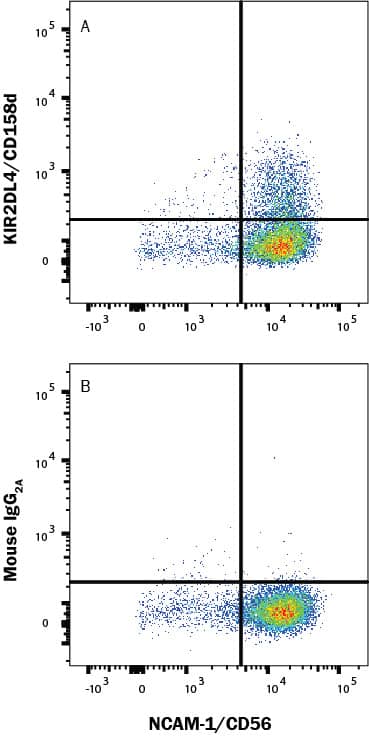Human KIR2DL4/CD158d PE-conjugated Antibody
R&D Systems, part of Bio-Techne | Catalog # FAB2238P


Key Product Details
Validated by
Species Reactivity
Validated:
Cited:
Applications
Validated:
Cited:
Label
Antibody Source
Product Specifications
Immunogen
Accession # Q99706
Specificity
Clonality
Host
Isotype
Scientific Data Images for Human KIR2DL4/CD158d PE-conjugated Antibody
Detection of KIR2DL4/CD158d in Human PBMCs by Flow Cytometry.
Human peripheral blood mononuclear cell (PBMC) NK cells were expanded with Cloudz Human NK Cell Expansion Kit (CLD004) for 10 days and stained with (A) Mouse Anti-Human KIR2DL4/CD158d PE-conjugated Monoclonal Antibody (Catalog # FAB2238P) or (B) Mouse IgG2A isotype control Antibody (IC003P) and Mouse Anti-Human NCAM-1/CD56 APC-conjugated Monoclonal Antibody (FAB2408A). Staining was performed using our Staining Membrane-associated Proteins protocol.Detection of KIR2DL4/CD158d in Human PBMCs by Flow Cytometry.
Human peripheral blood mononuclear cells (PBMCs) treated with 150 ng/mL Recombinant Human IL-2 (Catalog # 202-IL) for 6 days were stained with Mouse Anti-Human KIR2DL4/CD158d PE-conjugated Monoclonal Antibody (Catalog # FAB2238P) and Mouse Anti-Human NCAM-1/CD56 APC-conjugated Monoclonal Antibody (Catalog # FAB2408A). Quadrant markers were set based on control antibody staining (Catalog # IC003P). View our protocol for Staining Membrane-associated Proteins.Applications for Human KIR2DL4/CD158d PE-conjugated Antibody
Flow Cytometry
Sample: Human peripheral blood mononuclear cells (PBMCs) treated with Recombinant Human IL‑2 (Catalog # 202-IL) and Human peripheral blood mononuclear cell (PBMC) NK cells were expanded with Cloudz Human NK Cell Expansion Kit (Catalog # CLD004) for 10 days
Formulation, Preparation, and Storage
Purification
Formulation
Shipping
Stability & Storage
- 12 months from date of receipt, 2 to 8 °C as supplied.
Background: KIR2DL4/CD158d
KIR2DL4 (also known as 2DL4, p49, CD158d, KIR103) is a type I transmembrane protein of the killer cell Ig-like receptor (KIR) family expressed on NK and subsets of gamma deltaT and memory/effector alpha betaT cells. KIR2DL4 is a unique KIR (1-3); alleles are not clonally restricted but are expressed codominantly (4) in all activated NK cells and constitutively on CD56hi NK cells. KIR members with two Ig-like domains (2D) usually express domains D1 and D2, but KIR2DL4 expresses D0 and D2. Other long-tailed (L) KIR have two cytoplasmic inhibitory signaling domains (ITIM), but KIR2DL4 has one ITIM and also exhibits characteristics of activating KIR (2). An arginine within the transmembrane sequence of KIR2DL4 interacts with the signaling molecule Fc epsilonRI-gamma, while in activating KIR, a transmembrane lysine interacts with DAP12 (1, 5). The KIR2DL4 gene is highly polymorphic. Seven splice variants missing one or more exons have been identified, but it is not clear whether these are expressed. Several of the nine alleles identified encode a frameshift creating a prematurely truncated protein. It is estimated that up to 25% of humans do not express KIR2DL4 capable of reaching the cell surface (1, 7, 10). Human KIR2DL4 is 65-83% amino acid identical to other primates. KIR receptors have no structural orthologs in non-primates, although mouse Ly49 proteins are functional orthologs. Cross-linking of KIR2DL4 induces NK cells to produce IFN-gamma (6, 7); stimulation with IL-2 upregulates cell surface expression on CD56dim cells and allows cytotoxicity (7). Although a role in immune privilege of the fetus has been suggested due to reported recognition of fetal trophoblast HLA-G by KIR2DL4 in the maternal decidua (11), subsequent data have not supported this recognition (1, 9).
References
- Lanier, L.L. (2005) Annu. Rev. Immunol. 23:225.
- Faure, M. and E.O. Long (2002) J. Immunol. 168:6208.
- Selvakumar, A. et al. (1996) Tissue Antigens 48:285.
- Chan, H-W. et al. (2003) J. Exp. Med. 197:245.
- Kikuchi-Maki, A. et al. (2005) J. Immunol. 174:3859.
- Rajagopalan, S. et al. (2001) J. Immunol. 167:1877.
- Kikuchi-Maki, A. et al. (2003) J. Immunol. 171:3415.
- Gedil, M.A. et al. (2005) Tissue Antigens 65:402.
- Witt, C.S. et al. (2002) Eur. J. Immunol. 32:18.
- Goodridge, J.P. et al. (2003) J. Immunol. 171:1768.
- Ponte, M. et al. (1999) Proc. Natl. Acad. Sci. USA 96:5674.
Long Name
Alternate Names
Entrez Gene IDs
Gene Symbol
UniProt
Additional KIR2DL4/CD158d Products
Product Documents for Human KIR2DL4/CD158d PE-conjugated Antibody
Product Specific Notices for Human KIR2DL4/CD158d PE-conjugated Antibody
For research use only
